Mastering the Rules of Chemin De Fer

To master the rules of Chemin De Fer, focus on achieving a hand total closest to nine points by leveraging the card values strategically. Understanding the objective, card values, unique gameplay mechanics, dealing process, hand calculations, and decision-making when drawing the third card are key aspects. Mastering these rules enhances gameplay and influences winning potential, offering a competitive edge over opponents.
Key Takeaways
- Understand when to draw a third card based on total value ranges.
- Evaluate the initial two cards to make informed decisions during gameplay.
- Mastering rules improves strategic edge over opponents.
- Decision-making is crucial for maximizing winning potential in Chemin De Fer.
- Knowing rules enhances gameplay and increases chances of success.
Understanding Chemin De Fer Objective
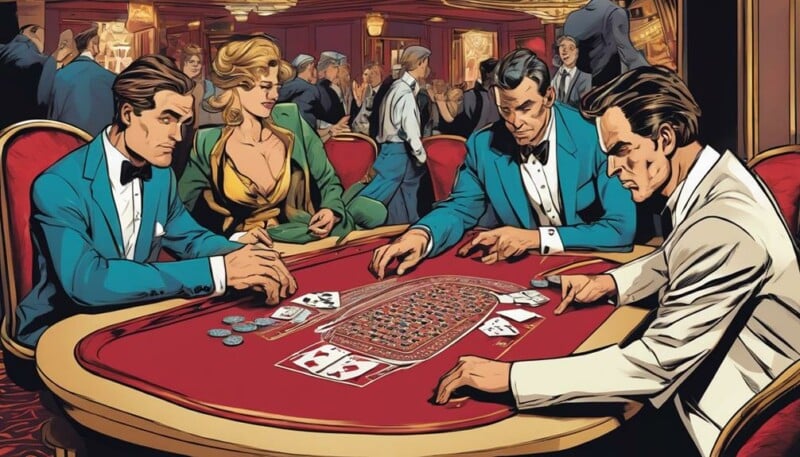
The primary goal of Chemin De Fer, a sophisticated and strategic card game, revolves around each player’s effort to achieve a hand total closest to the desired nine points. In this game, players aim to outdo the banker by reaching a higher point total without surpassing the key number of nine.
The hand values are determined based on the last digit of the total, making it essential for players to plan their moves to reach this ideal score. A hand totaling eight or nine points results in an immediate winning hand.
To enhance their chances of winning, players can choose to draw a third card following specific rules that govern this decision-making process in the game of Chemin de Fer.
Grasping Card Values

Shifting from the aim of understanding hand totals in Chemin de Fer, an essential aspect of mastering this game lies in comprehending the specific values assigned to each card in play. In Chemin de Fer, card values range from 1 to 10, with face cards worth 10 points each. Aces are valued at 1 point, contributing to hand totals based on their numerical value.
Players strategically aim to reach a hand total of 9 points or as close to 9 as possible by summing up the card values. Understanding the numerical values of cards is important for making informed strategic decisions during gameplay, as it directly impacts the scoring system and influences the overall outcome of each hand.
Unique Gameplay Mechanics
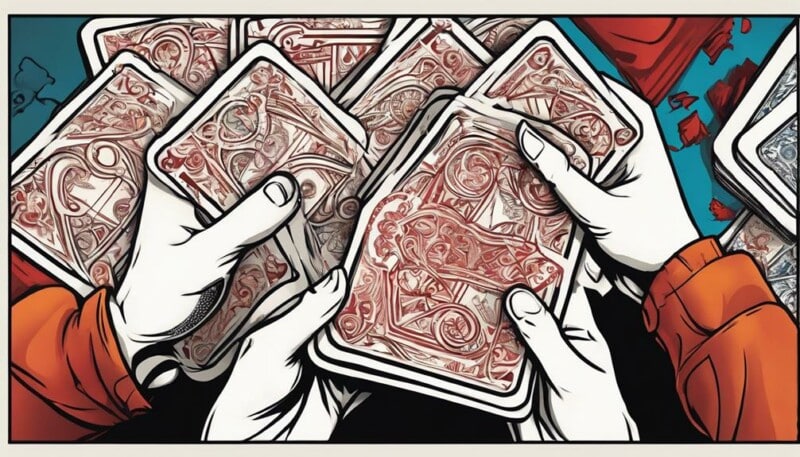
Within Chemin de Fer, a distinctive feature of its gameplay mechanics is the dynamic player-vs-player interaction created through betting against each other.
Unlike other Baccarat variants, players in Chemin de Fer take turns being the banker, adding strategic depth to the game.
With six decks of cards in play, the total number of possible outcomes increases, making each hand more unpredictable. Hand values in Chemin de Fer are calculated based on the last digit, introducing a unique scoring system that sets it apart from other card games.
This scoring system, coupled with players having the choice to draw more cards, contributes to the game’s slower pace compared to traditional Baccarat.
The betting dynamics between the banker and player further enhance the excitement and strategic decision-making in Chemin de Fer.
Dealing the Cards
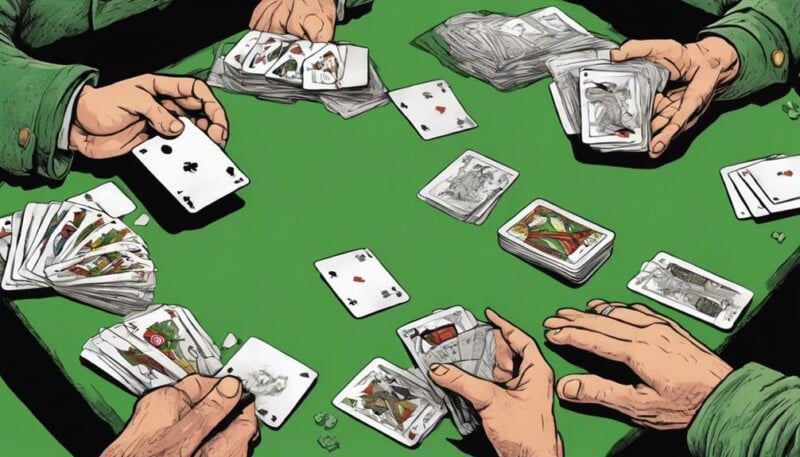
Understanding the points system is vital when dealing with the cards in Chemin de Fer. The card distribution process, player card options, and the dealer’s card handling all play an essential role in the game.
These points determine players’ strategic decisions throughout the gameplay, influencing the final outcome.
Card Distribution Process
At the commencement of a game of Chemin de Fer, each player and the banker are dealt two cards face down to initiate the card distribution process. This distribution process is pivotal in setting the stage for strategic decisions and determining hand values.
Key points to note during the card distribution process include:
- Two cards are dealt to each player and banker
- Cards distributed face-down
- Four initial cards were dealt in total
- Players begin making strategic decisions based on these initial cards
How the dealer distributes the cards in Chemin de Fer plays a significant role in shaping the gameplay and influencing the outcomes for the players involved.
Player Card Options
During the initial card distribution process in Chemin de Fer, players are dealt two cards each face down, setting the stage for strategic decisions and potential third card draws.
The players’ hand value determines whether to draw a third card or stand. Drawing a third card can alter the outcome greatly, as it may improve the hand or lead to exceeding the ideal hand value of nine.
Players must adhere to specific rules when deciding whether to draw a third card, considering the strategies employed by other players and the potential impact on the overall game.
Mastering the art of knowing when to draw a third card or when to stand is essential in excelling at Chemin de Fer.
Dealers Card Handling
The critical role of dealers in Chemin de Fer entails precise shuffling and meticulous distribution of cards to players, ensuring the integrity and fairness of the game. In this process, the cards are typically dealt face down, following specific dealer rules to maintain the game’s standards. The dealer’s responsibilities include:
- Shuffling the deck with care and precision to prevent any manipulation.
- Dealing the cards face down to players and the banker, adhering to established protocols.
- Ensuring each player receives their initial two cards promptly and accurately.
- Maintaining a professional and organized approach to card handling to enhance the overall gameplay experience in Chemin de Fer.
Improve your knowledge of classic games by reading our comprehensive guide on How Chemin de Fer Differs from Baccarat.
Calculating Hand Values
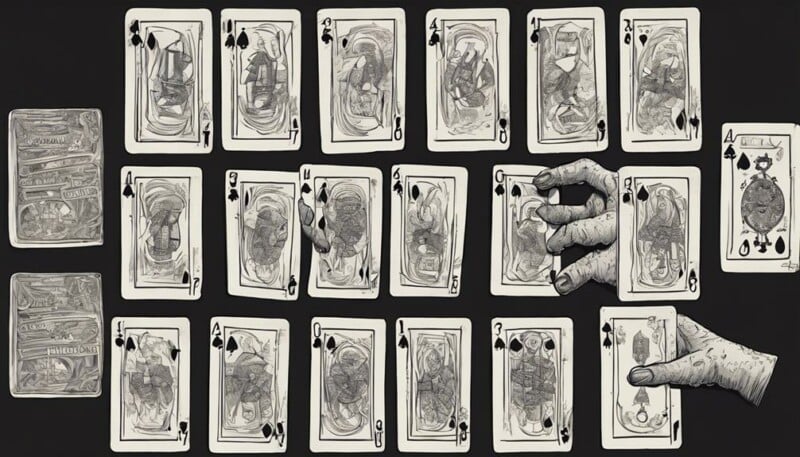
Understanding the points system in Chemin de Fer is fundamental to mastering the game.
Each card holds a specific point value, with aces being valued at 1 point and face cards at 10 points.
Calculating hand values involves summing these points and considering only the last digit for scoring, aiming to reach a total as close to 9 points as possible.
Hand Value Basics
Players calculate the total points of the cards held to determine the value of a hand in Chemin de Fer, with each card contributing a specific numerical value based on its rank. In this card game, the hand value basics include:
- Cards numbered 2-9 hold their face value.
- Aces are worth one point in hand calculations.
- Picture cards like Kings, Queens, and Jacks are valued at 10 points each.
- The goal is to reach a hand total of as close to 9 points as possible to win in Chemin de Fer.
Understanding these fundamentals is essential in managing card values effectively and aiming for a winning hand total in this exciting baccarat game.
Ace Value Strategy
Utilizing strategic ace value considerations plays a pivotal role in optimizing hand calculations and decision-making strategies in the game of Chemin de Fer.
In Chemin de Fer, the Ace consistently holds a value of 1 point, irrespective of the hand total. Calculating hand values involves summing the point values of all cards, with a principle that drops the first digit when the total surpasses 9, simplifying the final score determination.
A profound comprehension of Ace’s value is essential for making strategic decisions during gameplay. Accurate hand value calculations are paramount for maximizing winning probabilities in Chemin de Fer, emphasizing the significance of mastering the nuances of Ace’s value within the context of the game’s rules and dynamics.
Evaluating Bankers and Players
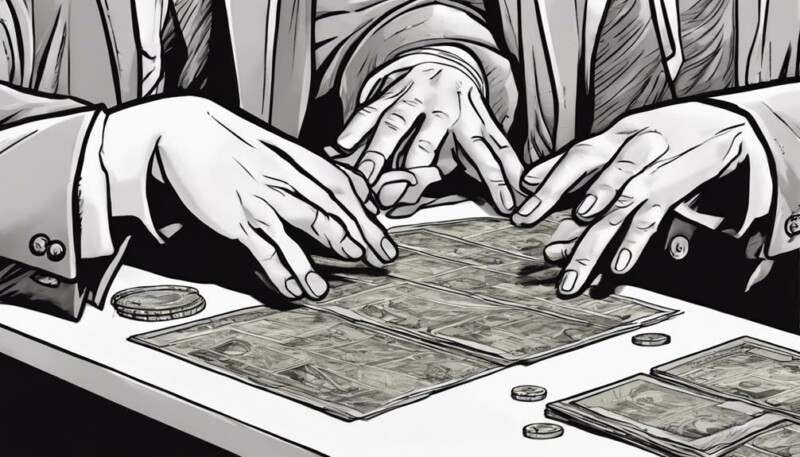
Assessing the relative strengths of the Banker and Players is a vital aspect of strategic gameplay in Chemin de Fer. Understanding the potential hand strength of each party is essential for making informed decisions during the game. To evaluate effectively, consider:
- The Banker decides whether to draw a third card based on specific rules.
- Players losing bets may indicate a stronger Banker hand.
- Players must decide whether to draw a third card based on their hand strength.
- Evaluating the Banker’s potential hand is pivotal in predicting the game’s outcome.
Mastering the art of evaluating Bankers and Players is fundamental in excelling at Chemin de Fer, as it sets the stage for strategic decision-making throughout the game.
Drawing the Third Card
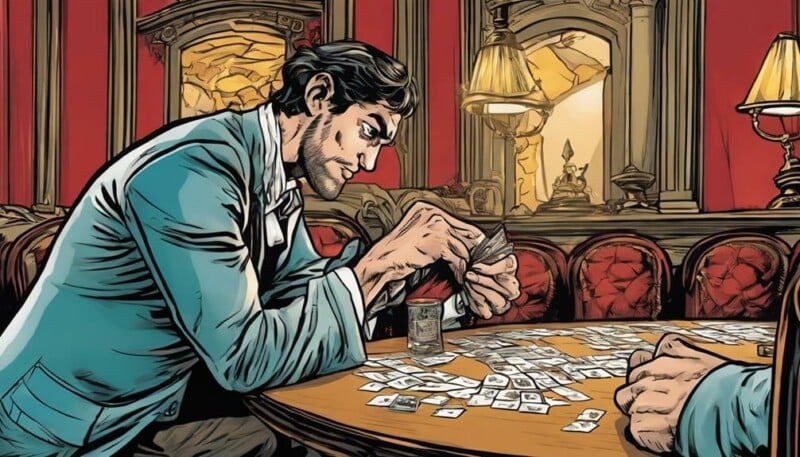
Strategically determining when to draw a third card in Chemin de Fer requires a keen understanding of the game’s rules and careful consideration of the current hand’s total value. In Chemin de Fer, drawing a third card is optional and can significantly impact the outcome of the game. Players must decide whether to draw a third card based on predetermined rules that dictate when it is allowed. By evaluating the total value of the initial two cards, players can make informed decisions aimed at maximizing their winning chances. Knowing when to draw a third card is essential for mastering the game and gaining an edge over opponents.
| Rules for Drawing the Third Card | Total Value Range | Decision |
|---|---|---|
| Draw if total is 0-4 | 0-4 | Draw |
| Draw if total is 6-7 | 6-7 | Stand |
| Draw if total is 8-9 | 8-9 | Natural |
Enhance your chances of winning by learning about the Better Odds Between Baccarat and Mini Baccarat
Conclusion
To sum up, mastering the rules of Chemin de Fer requires a thorough understanding of the game’s objectives, card values, and unique gameplay mechanics.
By learning how to deal with the cards, calculate hand values, and evaluate bankers and players effectively, players can improve their chances of winning.
Drawing the third card strategically can also significantly impact the outcome of the game.
Overall, a deep knowledge of the game’s rules and strategies is essential for success in Chemin de Fer.




